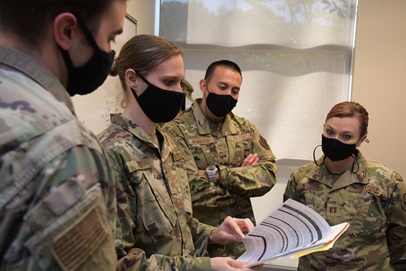Skip subpage navigation
By Maggie Baisley, Ph.D.
Sep. 21, 2022

Air Force photo by Barry BenaOftentimes, discussions surrounding suicide prevention focus on mental health services and diagnoses. Despite programmatic efforts to reduce suicide-related behavior in the military, the rates remain stagnant.1 In response, the Department of Defense is looking towards more comprehensive prevention efforts. In regards to those efforts, one important consideration is that many service members die by suicide without being diagnosed with mental illness or interacting with mental health services. For example, a previous Clinician's Corner Blog describing the U.S. Navy's Deep Dive investigation into suicide events noted, "With respect to clinical providers, Deep Dives have revealed approximately half of the decedents had any history of behavioral health care, with only approximately one-third of the total decedents having seen behavioral health care in the year prior to their deaths.." If we address the military population as a whole, rather than using an individual clinical lens, we may be better able to help all service members experiencing suicide risk, regardless of their mental health history.
Some experts suggest shifting to an environmental and population-level focus on suicide prevention, like examining ways to increase financial security for communities.2–4 In civilian and military communities, there are a number of environmental factors that lead to suicidal thoughts and behaviors. For example, one meta-analysis identified unemployment as a risk factor for suicidality.5 Commanders and other military leaders have influence and insight into service members' lives in a way that unique to most other workplaces and therefore may function as gatekeepers as well as primary influencers of wellness in their environments. "Gatekeepers" refers to: "individuals in a community who have face-to-face contact with large numbers of community members as part of their usual routine" and can serve as responsive bystanders to mitigate risk.6 As another example, the term "minority stress" has been used to reframe the comparatively higher prevalence of suicide risk in transgender veterans.7 This term helps focus attention on environmental drivers of distress and suicide risk, rather than pathologizing transgender identity itself.
Clinical providers are in a unique position to consult and advise commanders to be proactive about suicide risk management, beyond command directing high risk individuals to mental health services. Clinical providers within the Military Health System regularly communicate with commanders regarding specific service members as well as unit health. For more insight regarding the relationship between clinicians and commanders and its impact on suicide risk mitigation, consider reviewing another previous Clinician's Corner blog on the topic. These interactions present opportunities to educate and collaborate with commanders on preventative practices and interventions that are available, beyond the commander-directed referrals to mental health. Additionally, this suicide prevention clinical support tool is available to share with leaders:
References
- Department of Defense. (2021). Annual Suicide Report: Calendar Year 2020. https://www.dspo.mil/Portals/113/Documents/CY20%20Suicide%20Report/CY%202020%20Annual%20Suicide%20Report.pdf?ver=0OwlvDd-PJuA-igow5fBFA%3D%3D
- Blanco, C., Wall, M. M., & Olfson, M. (2021). A Population-Level Approach to Suicide Prevention. JAMA, 325(23), 2339–2340. https://doi.org/10.1001/jama.2021.6678
- Lund, C., Brooke-Sumner, C., Baingana, F., Baron, E. C., Breuer, E., Chandra, P., Haushofer, J., Herrman, H., Jordans, M., Kieling, C., Medina-Mora, M. E., Morgan, E., Omigbodun, O., Tol, W., Patel, V., & Saxena, S. (2018). Social determinants of mental disorders and the Sustainable Development Goals: A systematic review of reviews. The Lancet Psychiatry, 5(4), 357–369. https://doi.org/10.1016/S2215-0366(18)30060-9
- Christensen, H., Cuijpers, P., & Reynolds, C. F., III. (2016). Changing the Direction of Suicide Prevention Research: A Necessity for True Population Impact. JAMA Psychiatry, 73(5), 435–436. https://doi.org/10.1001/jamapsychiatry.2016.0001
- Milner, A., Page, A., & LaMontagne, A. D. (2014). Cause and effect in studies on unemployment, mental health and suicide: A meta-analytic and conceptual review. Psychological Medicine, 44(5), 909–917. https://doi.org/10.1017/S0033291713001621
- Burnette, C., Ramchand, R., & Ayer, L. (2015). Gatekeeper Training for Suicide Prevention. Rand Health Quarterly, 5(1), 16.
- Tucker, R. P., Testa, R. J., Reger, M. A., Simpson, T. L., Shipherd, J. C., & Lehavot, K. (2019). Current and Military-Specific Gender Minority Stress Factors and Their Relationship with Suicide Ideation in Transgender Veterans. Suicide and Life-Threatening Behavior, 49(1), 155–166. https://doi.org/10.1111/sltb.12432
Dr. Baisley is a contracted psychologist and scientific advisor to the Psychological Health Center of Excellence, Defense Health Agency. She served in the Army and has worked as a clinician in DOD and VA settings. She an advocate for ensuring health care equity for historically marginalized communities and optimizing the health care system to provide proper care for all service members.
You are leaving Health.mil
The appearance of hyperlinks does not constitute endorsement by the Department of Defense of non-U.S. Government sites or the information, products, or services contained therein. Although the Defense Health Agency may or may not use these sites as additional distribution channels for Department of Defense information, it does not exercise editorial control over all of the information that you may find at these locations. Such links are provided consistent with the stated purpose of this website.
You are leaving Health.mil
View the external links disclaimer.
Last Updated: September 14, 2023